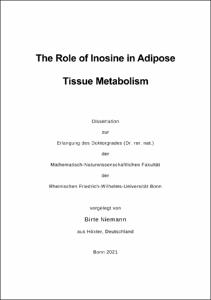Niemann, Birte: The Role of Inosine in Adipose Tissue Metabolism. - Bonn, 2022. - Dissertation, Rheinische Friedrich-Wilhelms-Universität Bonn.
Online-Ausgabe in bonndoc: https://nbn-resolving.org/urn:nbn:de:hbz:5-66237
Online-Ausgabe in bonndoc: https://nbn-resolving.org/urn:nbn:de:hbz:5-66237
@phdthesis{handle:20.500.11811/9781,
urn: https://nbn-resolving.org/urn:nbn:de:hbz:5-66237,
author = {{Birte Niemann}},
title = {The Role of Inosine in Adipose Tissue Metabolism},
school = {Rheinische Friedrich-Wilhelms-Universität Bonn},
year = 2022,
month = may,
note = {During the last decades, obesity has become a pandemic disease, associated with severe comorbidities, and a major problem for health care systems. Obesity results from energy imbalance, when energy intake exceeds energy expenditure. In this context, brown and beige adipose tissues are recognized as promising anti-obesity targets, because they express uncoupling protein 1, which mediates increased energy expenditure by uncoupling the respiratory chain from ATP production. Both types of thermogenic adipocytes (brown and beige adipocytes) can be activated by cold exposure and β3-adrenergic receptor agonists. However, due to cardiac side effects or insufficient oral bioavailability, targeting ß3-adrenergic receptors is not feasible as obesity therapy. Therefore, novel molecules and targets activating thermogenesis of adipose tissues need to be identified and investigated.
This thesis presents a novel approach to increase energy expenditure by stimulation of thermogenic adipose tissues with the purine inosine.
In order to investigate the role of inosine in adipose tissue metabolism a series of in vitro and in vivo experiments was performed. Various methods of molecular biology, such as mRNA and protein analysis, ELISAs, functional biochemical assays and histological analysis, were applied. In addition, several mouse models including administration of inosine to wildtype mice, global and adipocyte-specific ENT1-knockout mice as well as adenosine receptor A2B-knockout mice were used to study the effects of inosine in vivo.
The results indicate that inosine acts as a stimulatory autocrine/paracrine mediator in brown and beige adipose tissue. In particular, it was shown that inosine signaling in thermogenic adipocytes depends on adenosine A2B receptors. Moreover, ENT1 was identified as a relevant regulator of extracellular inosine concentrations and metabolism of thermogenic adipocytes. Consequently, increasing extracellular inosine concentrations - by administration of exogenous inosine or inhibition of ENT1 leading to increased endogenous extracellular inosine levels - represents a new approach to enhance energy expenditure of thermogenic adipose tissue. Thus, inosine and its transporter ENT1 could potentially be used as a pharmacological agent and as a target for future obesity therapy. Further studies are needed to elucidate the extent to which the results observed in the mouse models are transferrable to humans.},
url = {https://hdl.handle.net/20.500.11811/9781}
}
urn: https://nbn-resolving.org/urn:nbn:de:hbz:5-66237,
author = {{Birte Niemann}},
title = {The Role of Inosine in Adipose Tissue Metabolism},
school = {Rheinische Friedrich-Wilhelms-Universität Bonn},
year = 2022,
month = may,
note = {During the last decades, obesity has become a pandemic disease, associated with severe comorbidities, and a major problem for health care systems. Obesity results from energy imbalance, when energy intake exceeds energy expenditure. In this context, brown and beige adipose tissues are recognized as promising anti-obesity targets, because they express uncoupling protein 1, which mediates increased energy expenditure by uncoupling the respiratory chain from ATP production. Both types of thermogenic adipocytes (brown and beige adipocytes) can be activated by cold exposure and β3-adrenergic receptor agonists. However, due to cardiac side effects or insufficient oral bioavailability, targeting ß3-adrenergic receptors is not feasible as obesity therapy. Therefore, novel molecules and targets activating thermogenesis of adipose tissues need to be identified and investigated.
This thesis presents a novel approach to increase energy expenditure by stimulation of thermogenic adipose tissues with the purine inosine.
In order to investigate the role of inosine in adipose tissue metabolism a series of in vitro and in vivo experiments was performed. Various methods of molecular biology, such as mRNA and protein analysis, ELISAs, functional biochemical assays and histological analysis, were applied. In addition, several mouse models including administration of inosine to wildtype mice, global and adipocyte-specific ENT1-knockout mice as well as adenosine receptor A2B-knockout mice were used to study the effects of inosine in vivo.
The results indicate that inosine acts as a stimulatory autocrine/paracrine mediator in brown and beige adipose tissue. In particular, it was shown that inosine signaling in thermogenic adipocytes depends on adenosine A2B receptors. Moreover, ENT1 was identified as a relevant regulator of extracellular inosine concentrations and metabolism of thermogenic adipocytes. Consequently, increasing extracellular inosine concentrations - by administration of exogenous inosine or inhibition of ENT1 leading to increased endogenous extracellular inosine levels - represents a new approach to enhance energy expenditure of thermogenic adipose tissue. Thus, inosine and its transporter ENT1 could potentially be used as a pharmacological agent and as a target for future obesity therapy. Further studies are needed to elucidate the extent to which the results observed in the mouse models are transferrable to humans.},
url = {https://hdl.handle.net/20.500.11811/9781}
}






